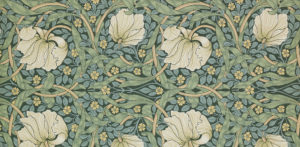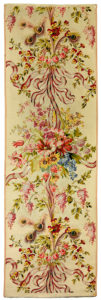
© Museum für Gestaltung Zürich / Kunstgewerbesammlung / Zürcher Hochschule der Künste
Ornaments divided opinion
In the nineteenth century, a heated debate broke out about ornaments and their production. The issue dominated the world of art and culture and was a turning point in the aesthetics of modernity.
“There is no accounting for taste” as the saying goes. This does not mean, as many people believe, that everyone must be permitted their taste. The idea that we should not be at odds over taste dates back to feudal times. At that time, people believed that you either had taste or you did not. Taste is the culmination of a way of life built up over generations. So, really no reason to argue. But this changed with the emergence of industrialisation and mass production in the nineteenth century, with production capabilities being broadened by technology and science. People began to quarrel quite unbelievably about taste – primarily to reject one another’s preferences.
These differences of opinion were most evident in the debate about ornaments. Paradoxically, the neo-Renaissance, neo-Baroque and neo-Gothic styles all made their return to historicism in the bourgeois era of industrialisation, along with orientalism and Japonism – their common denominator? Ornaments. Some now argued about the nature of designs whilst others quarrelled over production. English art historian John Ruskin (1819–1900) somewhat denounced the total reification at work in mechanical mass production. For him, industrially manufactured ornaments were cold and sterile due to their machine-generated perfection. Ruskin had a formative influence on the Arts and Crafts movement, for which skilled dexterity and craftsmanship were essential. In the course of the oriental renaissance, not only was there a rediscovery of oriental craftsmanship in terms of gems, fabrics and ceramics, but with the triumph of the arabesque, there was also what many regarded as an empty, frivolous foreign infiltration of their own, clear line and generally as a violation of straightforwardness.

William Morris (1834–1896) assisted by Philip Webb (1831–1915) and Henry Dearle (1860–1932), The Forest, made by Merton Abbey Workshop, London, by William Knight, John Martin and William Sleath, 1887.
© Victoria and Albert Museum, London
At the end of this dispute over taste is Adolf Loos’s (1870–1933) provocative slogan about the ornament as a crime: “The evolution of culture matches with the elimination of ornament from useful objects”. The avant-gardes of Bauhaus hoped to leave all historicism behind and finally become modern and masculine Republicans without any frills, overcoming all effeminate, oriental, idolatrous reifications. The idea was to develop a means of production suitable for the industrialist that achieved more and was aesthetically more interesting than traditional craftsmanship. This heralded the new, modern aesthetics in which the form simply had to restrict itself to following the function. The opulence of an ornamental flourish was met with the minimalistic “less is more” attitude.
However, the desire for ornaments could not quite be fully eradicated. It returned in all manner of forms and not just in a neo-Baroque opulence which could still be attributed to the new moneyed elites who, still lacking in good breeding, felt the need to stand out. With the return of the ornamental, function itself has often become an ornament, in a dialectic ploy. In many cases, the ornament has returned with a self-deprecating affirmation, as rubbish, for example. Or as logomania – ornamentalisation of a brand’s convoluted lettering, which takes that which should guarantee the trademark, that which should be guaranteed, and ironically subverts it: poor taste is good taste.
But in the long run, we are facing a renaissance of the “favourite piece”. And favourite pieces are, perhaps by their very nature, decorated, an adornment, in short, the ornament cannot be mastered. Our interior design, our clothes, our food – industrially produced under the most dreadful conditions for humans and nature: perhaps we should not constantly get rid of them, throwing them away every season. Instead slow fashion, slow food and slow design. This is exactly what requires a savoir faire between craftsmanship and technology, as people in Eastern Switzerland are still managing to demonstrate with textiles, for example. The flowers, the peaks that blossom there ornamentally, do not have to promote an aesthetic of the good, the true and the beautiful, as was the intention of the Arts and Crafts movement, but may even adorn the hills as sultry flowers of evil.

Furnishing fabric in the style of the 18. century, silk manufacturer Maison Lamy et Gautier, Lyon, around 1900–1905. Silk velvet.
Musée des Tissus, © Lyon, MTMAD – Pierre Verrier, Inv.-Nr. MT 27696.2
In Search of Style. 1850 – 1900
National Museum Zurich
23.3. – 15.7.2018
A journey through time exploring Europe and Switzerland in the second half of the 19th century illustrates the search for innovation and style for new interiors, everyday products, paintings and buildings. This was an age of rapid technological change and social upheaval – not unlike today. Through selected objects from the worlds of architecture, art and craft, we can gain an insight into the various juxtapositions in style that marked a controversial era: specimen collections were built up, schools of arts and crafts were established and major cities began to take on the visual aspect we are familiar with today. A passionate debate on suitable style was born.



